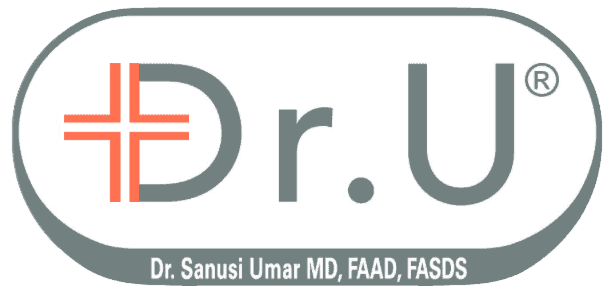With the popularity of beards, sideburns, and facial hair, many men choose to embrace this style trend as part of their reveryday look. Yet, due to genetic reasons, not everyone can grow out their facial hair as desired. For follicularly challenged individuals eager to sport a beard or other forms of facial hair growth, beard transplant surgery is an option to consider. Dr. U offers patients a more advanced and specialized version of this procedure, utilizing a wider range of donor hair beyond just the conventional scalp areas. By utilizing various hair thicknesses with the Dr.UGraft Zeus, doctors can provide more natural and realistic looking results for their patients.
Watch this fascinating video that describes the intricacies and details that would rarely occur to most people when they try to conceptualize what performing this procedure would entail.
Facial Hair Restoration by Hair Transplantation Created Beard to Cover Surgical Scars. A Testimonial
Sign up for FREE online consultation from Dr.U himself – https://dru.com/free-online-consultation-hair/Learn more about beard reconstruction surgery here- h…
Who Is Beard Hair Restoration For?
Opting for facial hair transplant surgery is an individual choice where each person’s reasoning and goals differ. Beard transplant surgery can be an excellent course of action for patients with the following types of intent in mind.
- the ability to stay on top of current style trends
- the inner desire to follow cultural norms
- the need to mask facial deformities
- the motivation to pursue a transgender identity
Are You Having Trouble Growing A Beard, A Mustache, or Sideburns?
Though beards are in vogue, many men are not able to grow out their facial hair accordingly. Growth may be uneven, sparse, or patchy. And some men cannot grow any hair on their face.
Does Testosterone Matter?
According to many medical experts, most men already have very similar testosterone levels. And so, they argue that having less testosterone is probably not the reason you may be having trouble growing out a full and even beard.
The Relationship Between DHT and Beard Growth
There are also those who endorse the opposite viewpoint. Testosterone breaks down into a hormone called DHT which is activated by an enzyme in the hair follicles of your face and body. According to Dr. U and other medical specialists, DHT enhances facial and body hair growth [1] like a fertilizer.
Check For Hypothyroidism
Hormones produced by your thyroid gland help in the maintenance and development of your hair follicles, according to the International Journal of Trichology.
People suffering from hypothyroidism (i.e. underactive thyroid gland) are likely to experience hair loss on the scalp, body, and face.
Your Genes Affect How Well You Can Grow A Beard, But Surgery Can Change This
Your DNA has the instructions for creating every structure in your body. And this, of course, affects your ability to grow facial hair. However, thanks to modern hair transplant methods, you can now count on surgery to help you attain the beard you’ve always wanted.
Reproducing Natural-Looking Facial Hair Characteristics With Facial Hair Restoration Procedures
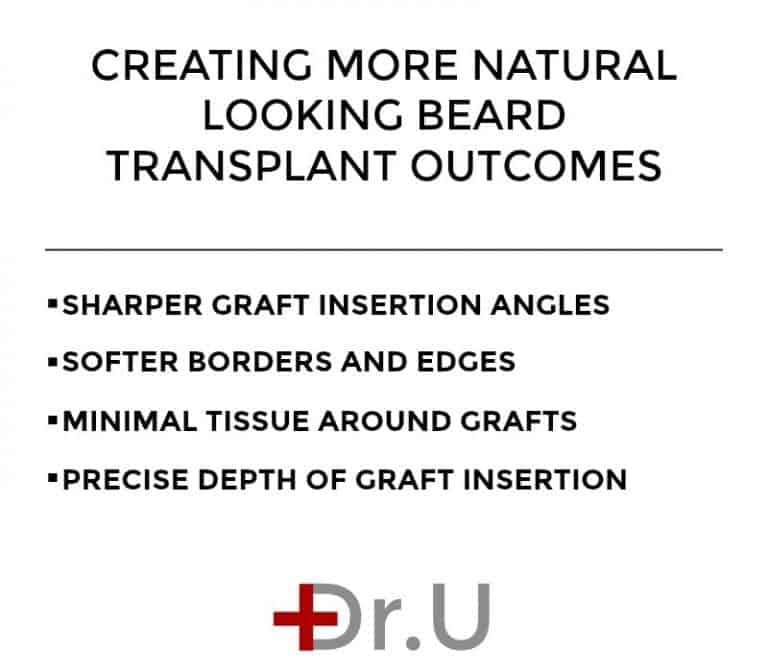
According to Dr. U, hair quality changes in different regions of the face. This includes:
- the jawline border
- the cheek
- the goatee
- the under neck region
This means that facial hair growth does not have a single uniform thickness. When studying a full beard’s features, different hair character is noticeable particularly on the cheek, the goatee region, and under the neck.
Dr. U also points out that the beard and facial hair contours edges tend to have a softer border compared to the main regions.
To create this detail, it is necessary to harvest thinner hair. With the use of the specialized features of Dr.UGraft™, these types of grafts can be acquired from various regions outside the conventional donor regions of the scalp.
Examples include:
- nape
- pubic area
- legs
Aside from these three areas alone, the Dr.UGraft™ Intuitive FUE device can be used to harvest grafts from any region which produces hair of a desirable quality. Different areas of the body, whether it’s the scalp, face, nape, legs, chest, etc., will have different levels of skin density thickness. The standard speed and torque of basic FUE rotary punches may be insufficient or excessively powerful in these various contexts, resulting in graft injury. The intuitive capability of Dr.UGraft™ makes it possible to precisely adjust the performance settings to harvest follicular units from anywhere on the body safely.
Dr.U’s Tenets of Creating a Natural Looking Facial Hair Transplant Outcome
Anyone interested in beard hair restoration surgery must familiarize themselves with the set of measures necessary to create the best and most natural-looking results possible. According to Dr.U, the following implementations are vitally important considerations.
- The angle of insertions needs to be hyperacute, much smaller, and sharper compared to regular head hair.
- As discussed previously, the borders of the facial hair regions need to softly and gradually transition to the main regions.
- There also needs to be minimal tissue around the hair follicles, resulting in the formation of bumps on the skin surface.
Finally, the depth at which the grafts are inserted needs to be precise and perfect. If they are inserted too deeply, this will result in pitting. Likewise, if they are inserted at a shallower depth (especially with larger amounts of bulk around the graft), this will result in the formation of cobblestone-like bumps on the skin’s surface.
Patient Example of Dr. U’s Beard Hair Restoration Surgery
Dr. U’s expertise enables him to overcome even the most challenging patient goals. In this particular example, normal beard growth already existed on the left side of the face. However, the patient was born with a large congenital nevus covering much of the right half of his face. At a young age, he underwent a series of surgeries that replaced the dark regions with skin grafts taken from his neck. These new areas were not capable of producing beard hair which mirrored his left side. He sought Dr. U’s help to reconstruct a perfectly symmetrical beard on both sides of his face.
To complete the patient’s beard growth, Dr. U needed to study the left half of the face carefully. Secondly, he found it necessary to match the hair thickness that was already present. Scalp hair could not be used because it was far too thick. This would have produced an unnatural hair thickness on the right side compared to the left.
Instead, he could attain softer hair types from the patient’s legs and nape, using the specialized intuitive features of his Dr.UGraft ™ technology.
Also, in this case, the newly reconstructed beard would help to camouflage the seams from the edges of the skin graft so that it would be less visible. Dr. U redesigned the patient’s beard contours on both sides of the face so that their peaks would project further inward to camouflage the linear scarring more fully.
Dr.U inserted every donor graft by laying each one of the hair follicles as flat as possible according to the patterning set forth by nature. He also reserved the softest hairs for the very outer transition edges of the beard. The coarser nape hairs were inserted to then fill in the central regions of the recipient areas. Before doing so, he carefully studied the patient’s beard hair patterning present on the left half of his face. He then replicated these lessons to produce a mirror-like symmetry that would complete the patient’s overall beard.
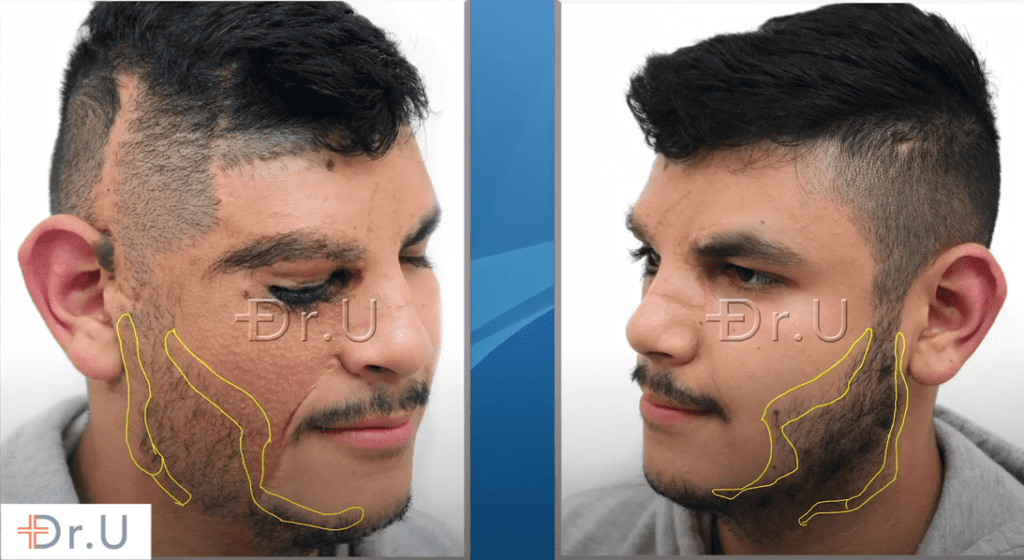
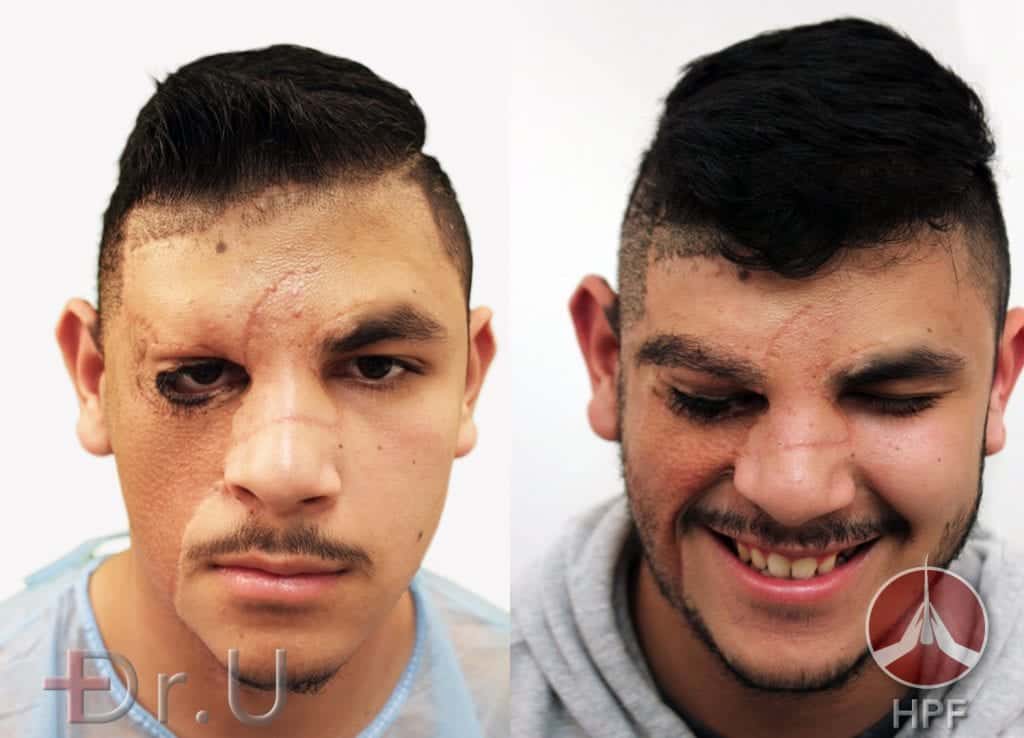
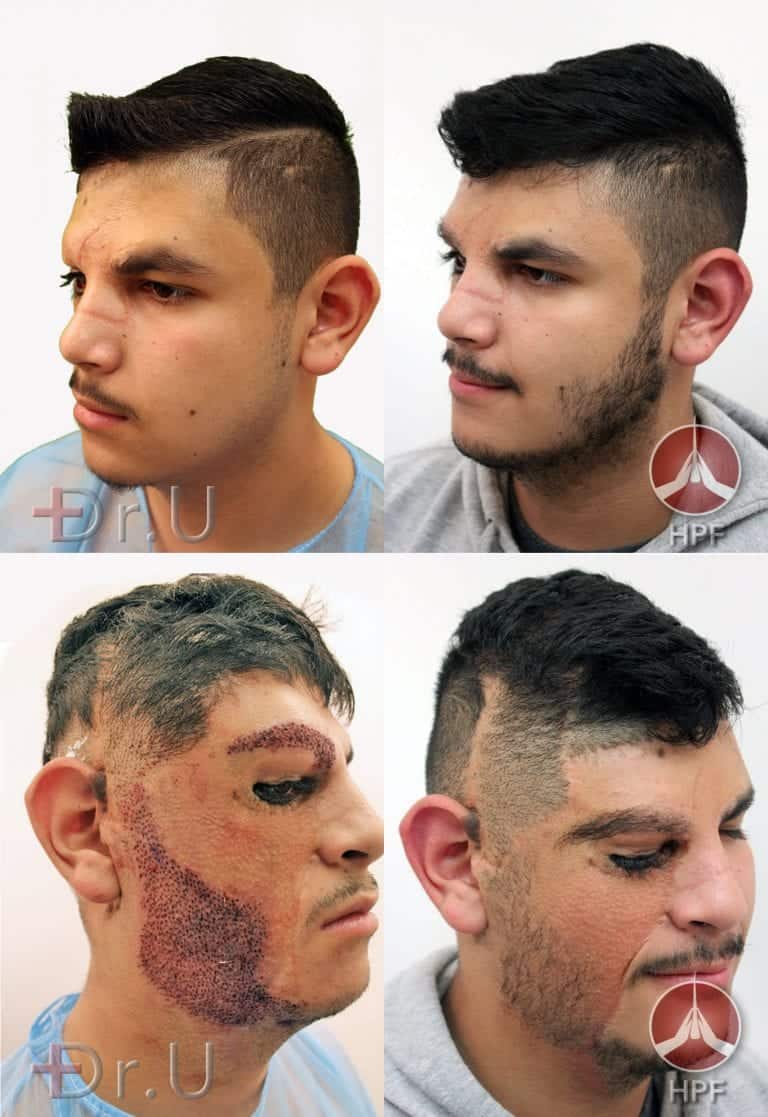

VIDEO: Dr.U Explains The Must-Have Details Needed For The Best Beard Restoration Results Possible
The primary goal of beard hair restoration surgery is to produce the most natural-looking outcomes possible. Awkward 90-degree angles, poorly placed hair, and the wrong hair thickness will look very contrived, conspicuous, and artificial. Since the face is highly visible and what other people notice when they talk to you, mistakes such as these will warrant correction. The only way to revise beard surgery errors is by way of future repair procedures, an added cost that most people would feel reluctant to undertake. In this video, Dr.U explains the most important details necessary for creating a final beard that looks like the patient never had surgery in the first place and was able to grow it himself.
Evolution and the History of Beards
While the millennial generation of males has popularized the aesthetic of beards, it is still quite interesting to learn about the timeless history of facial hair.
During the prehistoric ages, beards served to provide warmth and signal aggression by providing the appearance of a longer jawline.
A modern 2012 study published in Behavioral Ecology confirmed this. The research was led by a psychologist, Paul Vasey and Barnaby Dixon [2]. It involved young men in their early 20’s of European or Samoan descent with full beards. The first part of the study photographed them making facial expressions, happy, neutral, or angry. After shaving their beards, they were again photographed while portraying these emotions. According to the findings, when wearing beards and making angry facial expressions, the subjects were perceived as more physically aggressive than when they did not have the beards.
As opposed to warmth, the evolutionary purpose of growing beard hair may actually serve to protect the face from the sun. Researchers Valerie Randell and Ebling found that body hair tends to grow at different rates during different seasons. They discovered that beards in men tend to grow 50-60% more rapidly in the summer versus the winter months.
In ancient times, beards were worn for adornment purposes. The Egyptians died their beards brown and reddish hues. But kings and queens wore metal beards fastened to their heads with ribbon. The Mesopotamians and Greeks used curling rods to create formations like curls, ringlets, and tiers. In the later part of Roman history, beards were worn primarily by philosophers.
Trending Beard Styles
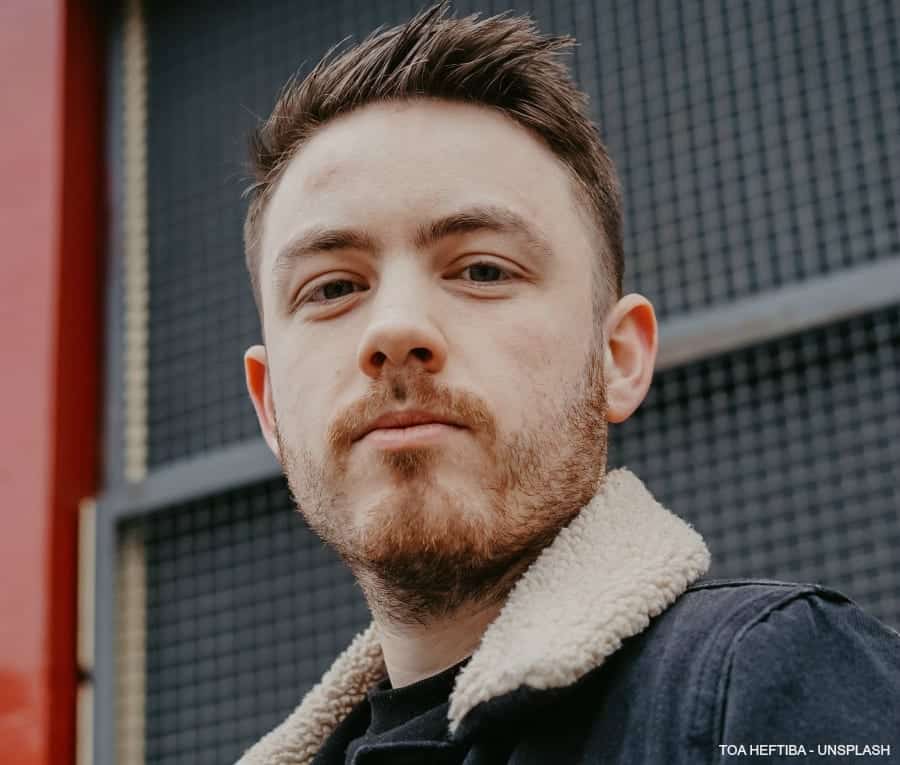
Many men choose to wear beards to help add dimension to their faces. It can conceal a weak or receded jaw, for example. Furthermore, facial hair also adds a stronger element of maturity and masculinity to one’s appearance.
Here is a brief list of trending beard styles based on the shape of the face, which can be created with shaving techniques.
Round Face
Certain beards can enhance the appearance of round faces by adding more visually interesting elements.
- The Van Dyke beard is comprised of a detached mustache and a goatee.
- A style called the Short boxed beard is created with minimal amounts of hair on the chin, jawline, and mustache area with the sides well-trimmed.
- The Balbo beard is worn with no sideburns and paired with a floating, detached mustache. Hair is left on the chin and jawline with a center strip.
Oval Face
For the oval face, a short stubble beard can provide a flattering addition. Called the 3-Day Stubble Beard, the facial hair is closely shaved to resemble three days of stubble.
Rectangular Face
The Chin Strip or a simple vertical line on the chin is recommended for rectangular-shaped faces. Likewise, individuals with this facial shape may also consider the Chin Strap Style Beard, where hair circles the chin without the presence of a mustache.
Square Face
Three beard styles can be flattering on square-shaped faces. With the Circle Beard, the hair on the chin and mustache are left connected to form a circle. Another option is the Royale Beard which consists of a mustache, a patch of hair on the chin, and a vertical chin strip. With goatees, there is a small beard consisting of hair localized on the chin.
Celebrity Beard Inspiration
The notion that beards convey masculinity, maturity and power is illustrated quite vividly by well-known celebrities who embrace facial hair’s rugged and laid-back look.
- Ben Affleck
- Brad Pitt
- Jason Momoa
- Samuel L. Jackson
- Chris Hemsworth
- David Beckham
- Jake Gyllenhaal
- Hugh Jackman
- George Clooney
In this list of examples, many of these actors are older than millennial-aged, which suggests that beards may not just be a fleeting soon-to-pass trend but may well be on their way to becoming a more timeless, classic fixture in modern male styling.
If you are in the greater Los Angeles area and would like to consider a beard transplant procedure by Dr.U, please send your information and details about your goals through our complimentary online consultation form.
Frequently Asked Questions – Beard Hair Restoration Surgery
If I get donor hair extractions from other parts of my body for a beard transplant surgery, outside the scalp, such as the legs, will I be left with permanent scarring?
Scarring is inevitable with any hair extraction performed on the skin. However, the extent of scarring can be greatly minimized to where other people do not notice it. Dr.UGraft™’s technology is designed to create (upside-down) wound cavity shapes that result in optimal skin healing results with no visible bumps or redness. Patients who have had body hair removed on open areas like the legs and beard have been able to have extractions performed without friends, family, and onlookers noticing any signs of surgery.
Why does Dr.UGraft™ technology consider skin thickness, more so than hair angles, when performing extractions on the body for beard hair restoration surgery?
Dr. U has observed that skin thickness has a far more direct relationship to hair transplant graft transection than hair curliness. In fact, some patients with relaxed hair can experience higher rates of transection compared to individuals with tightly curled, Afro-textured hair. The differences in their skin thickness can explain this. By focusing on this particular variable, the Dr.UGraft™ technology can significantly minimize transection rates. This is important for body-to-beard transplant surgery as well as body to scalp transplantation.
Will hair from other areas of my body grow longer or change color once placed in the beard regions on my face?
No, once hair is transplanted, the follicles transferred will have the same genetic DNA. This will cause them to display the same characteristics that they had in their original location.
References
- Farthing MJ, Mattei AM, Edwards CR, Dawson AM. Relationship between plasma testosterone and dihydrotestosterone concentrations and male facial hair growth. Br J Dermatol. 1982 Nov;107(5):559-64.
- Barnaby J. Dixson, Paul L. Vasey, Beards augment perceptions of men’s age, social status, and aggressiveness, but not attractiveness, Behavioral Ecology, Volume 23, Issue 3, May-June 2012, Pages 481–490,
Further Reading
Discover how beard hair can be repurposed to restore severe baldness at Norwood 7
